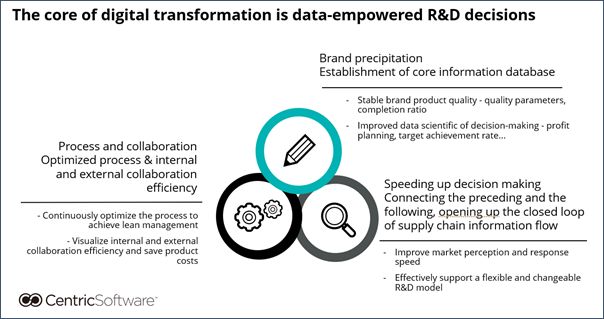Centric Software discusses traditional retail companies' e-Commerce response and D2C conversion strategy.
According to the 2020 4Q results announced by Nike, quarterly sales fell 38% compared to the same period last year, but online sales increased by a whopping 75%, accounting for 30% of total sales.
Nike planned to increase the proportion of online sales by 30% by 2023, but COVID-19 has advanced its target by three years.
The reason Nike was able to achieve digital sales growth despite the COVID-19 outbreak was that it placed the priority of its corporate strategy on D2C (Direct to Consumer) in 2017 and continuously carried out customer-oriented digital innovation.
Based on the D2C strategy, Nike can quickly launch the products for customers by reducing the production cycle of existing products in half, and breaking away from the existing offline store-centered sales strategy, it has organically connected online channels such as Nike+ membership and Nike.com with existing offline channel to provide a better customer experience.
After COVID-19 spread, in addition to Nike, major fashion companies such as Uniqlo, Adidas, H&M, and Prada are also accelerating digital transformation strategies with the aim of strengthening the D2C platform.
D2C is a method in which traditional retail companies directly sell products to customers through their own sales channels without going through intermediate wholesale and retail such as department stores and supermarkets.
It is not through entering department stores or offline stores, but by establishing a separate digital platform for product sales and using social media to strengthen marketing and relationships with customers.
In addition, since it directly deals with customers without going through intermediate wholesale and retail, it is possible to reduce the entry cost and sales fees, thereby increasing sales by selling products to customers at reasonable prices.

The reason why traditional retail companies are expanding D2C channels is to strengthen digital-based sales channels as online-based contactless consumption increases after COVID-19, but the more important reason is to build direct connection with customers.
It aims to secure continuous sales by identifying changing customer needs through the relationship, planning and launching products that customers need, and establishing long-term strong relationships.
In order for traditional retail companies to pursue D2C channel strategies, it is important to strengthen customer inflow through social media and establish relationships with customers to induce purchases, but above all, planning and R&D must be conducted systematically to achieve success, allowing new products reflecting the latest trends and customer needs can be released every week.

Source: Centric Software
In order to analyse customer needs and release products quickly, the first step is to use collaboration tools to share the entire process stage not only to production employees but also external partners for quick decisions at all production stages.
Communication must be conducted systematically in order to respond to rapidly changing market trends and customer needs.
Second, it is necessary to design products quickly and develop prototypes using data-driven decision making such as market demand analysis, latest trend identification, customer feedback, and 3D product design, virtual sampling, and digital libraries to shorten R&D period.
Lastly, it is necessary to establish a production network with various suppliers required for product production, and systematic supply chain management and effective collaboration should be preceded to shorten production time and bring products to market quickly.
Traditional fashion retail companies such as Louis Vuitton, Camilla, P.E Nation, Calvin Klein, Mango, Under Armour, Camper, Tesco, Woolworths, Marc Jacobs, Michael Kors and Superdry have been introducing and utilising PLM (product lifecycle management) solutions to secure the capabilities necessary to shorten the production cycle through the establishment of internal/external collaboration systems for D2C establishment, product planning based on customer needs, and systematic supply chain management.
According to Centric Software, a global PLM solution company, after the COVID-19 outbreak, traditional retail companies are increasingly adopting PLM to reinforce e-commerce to promote digital innovation and expand D2C business.
Using Centric PLM's Digital Board, it is available to strengthen group decision-making and collaborative design capabilities such as product review, design meeting, buying session, and fit session remotely within the platform.
Through 3D Connect, 3D Prototyping and Fit Review, Product planning and R&D time are shortened, and products are quickly released to the market.
Italian luxury brand, Salvatore Ferragamo, also introduced Centric Software's PLM solution to secure product development visibility, simplify design and manufacturing processes, and build a team collaboration platform for pursuing a digital transformation initiative called 'Innovation and Tradition, Together'.

Source: Centric Software
McKinsey analyses that the COVID-19 crisis will accelerate the pace of digital transformation within the next year, and flexible product development and on-demand production through automation will rapidly increase with short lead times.
In order to cope with such changes in product development and production systems, it is predicted that the D2C conversion of traditional retail companies will take place quickly.
However, in order to transform D2C to promote a digital transformation strategy rather than a simple e-commerce sales strategy, speed, flexibility, openness, and a foundation for collaboration should be established at all stages of the value chain from product planning and product launch to success.
Click HERE to download the whitepaper to learn How Can Apparel Brands Retain Existing Consumers and Strive for an Increase After Breaking Through the Traffic Bottleneck.



